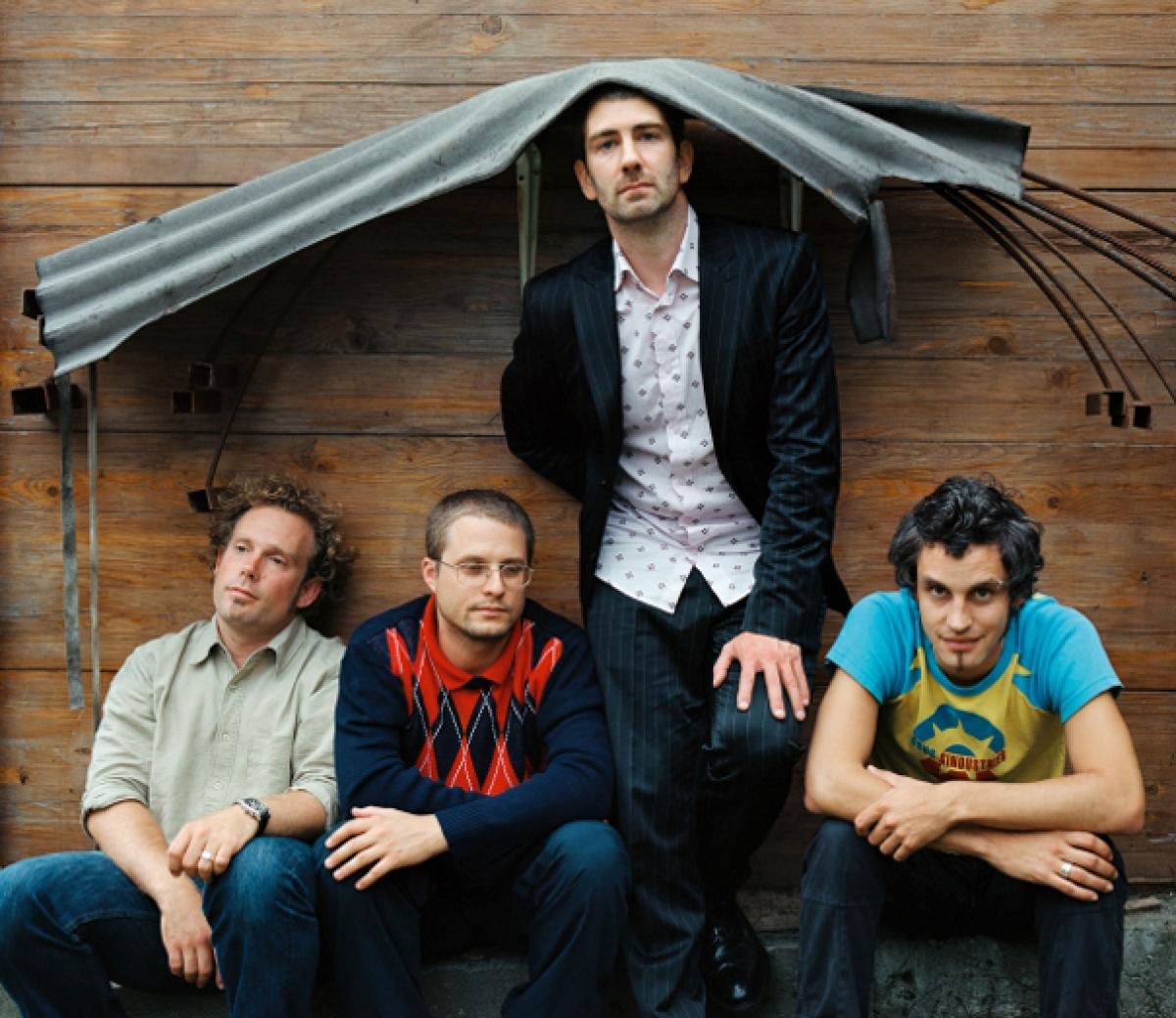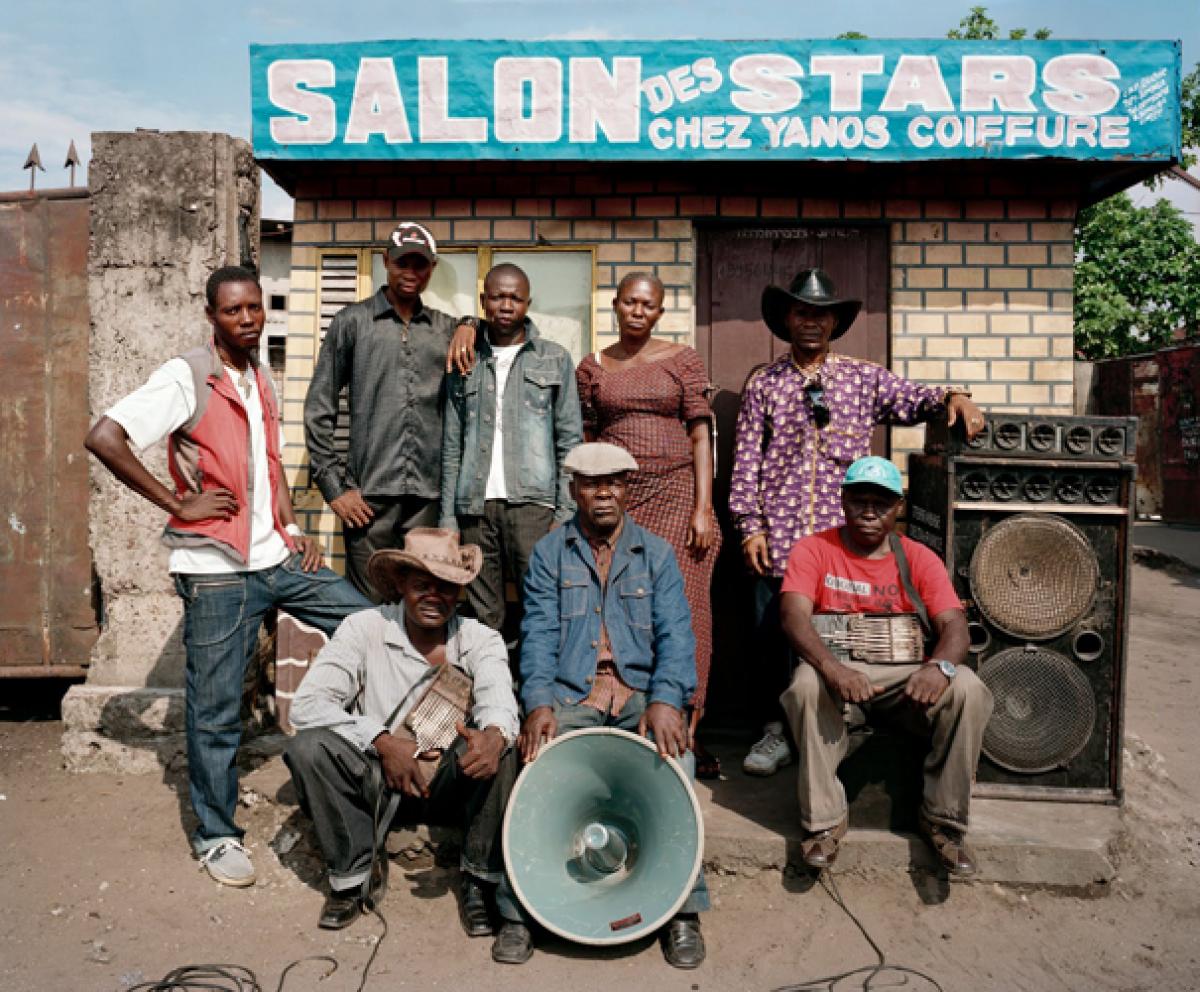
How You Can Become a Pig and Lose Weight, Too
After Christmas, after New Year’s, when in the U.S. we are simply trying to get back into our normal routines and remember what year to write on our checks, Dominicans are gearing up for another holiday season, one of a completely different kind...
They are preparing for carnival, which in the Dominican Republic lasts well over a month. When I spent a year living in Santiago de los Caballeros, the country’s second-largest city, it struck me that there could be no better way to get to know the culture and people than by participating in their biggest celebration.
Dozens of towns and cities around the country have developed their own, unique carnival costumes and masks – a result of differences in history and ethnic makeup. So, while not as well known as the better-funded carnivals of Trinidad or Brazil, this island may have a more diverse array of carnival celebrations than anywhere else in the Caribbean.
Santiago makes its contribution to the mix with the lechón, a fantastical creature combining the outfit of a court jester with the face of a duck sporting enormous horns or chifles. Lechón actually means «pig», but it’s a figurative, not literal, label. A hundred years ago, these characters were considered dirty and disreputable, as the role was typically played by the very poor.
The tradition is far older than that, however. Dominican carnival aficionados often boast of having the first documented carnival in the New World. It’s natural, since the original colony was founded by Chris Columbus himself (another frequent source of boasts). And in fact, a character in lechón-like apparel appears in Cervantes’s Don Quixote. So it is a venerable vocation, if not entirely dignified: the main duties of the lechón include dancing along a lengthy parade route, cracking a whip in a menacing fashion, and whacking passersby as hard as possible with inflated, hardened animal bladders or vejigas.
In truth, I was in town to work on my ethnomusicology dissertation, which was on the music called merengue típico. But since I didn’t have to report back to anyone, who was to know how much time I was spending designing carnival costumes rather than playing accordion, building strength in my whip arm rather than typing up field notes? In any case, I rationalized, few activities could get me more involved in the life of the barrios, lower-class neighborhoods, than could the barrio-based carnival groups. So I started asking around.
I soon found a carnival mentor in José Reyes, a Santiago native who had been dressing up for carnival since childhood. He hooked me up with a group of lechones from the barrio of Pueblo Nuevo. Luckily for me, Los Confraternos already had a female member called Betania who was willing to show me the ropes – women only started playing lechón about 15 years ago, and are still a bit of a curiosity. At our first meeting, José came along to introduce me and to give us all a talk about our duties. He told us, “When you’re a lechón, you’re in charge. You decide who you hit and when.” But since a vejigazo can really hurt, you must also know how to dole it out, namely, on the back for men and on the butt for women.
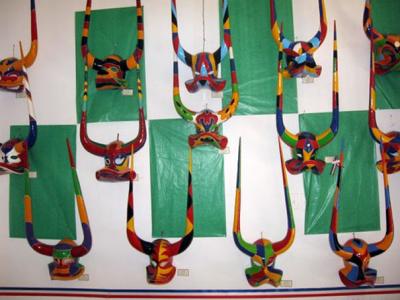
I felt I was ready to take on these weighty responsibilities, so Betania, I, and the rest of the Confraternos set about acquiring all necessary accoutrements. These included a heavy jumpsuit covered in sequins, mirrors, bells, and buttons; a morcilla, or sausage-like cummerbund; custom-made, multicolored, high-top sneakers; and of course a couple of smelly bladders. But most important was the mask, a four foot papier-mâché creation covered in glitter.
A hundred years ago, roving bands of lechones from the barrios of La Joya and Los Pepines discovered they needed a way to tell themselves apart if they were to attack each other properly. Things are less violent today, but the distinction remains between the smooth-horned Joyero mask with its grimacing expression and the Pepinero with upturned bill whose horns resemble porcupines, zillions of tiny chiflitos growing from the main stalk. A new style has become associated with Pueblo Nuevo, in which hundreds of brightly-colored flowers sprout from the horns. But we instead chose a style that fused the Joyero and Pepinero into one impressive whole.
At last, I was ready to hit the road with my fellow lechones.
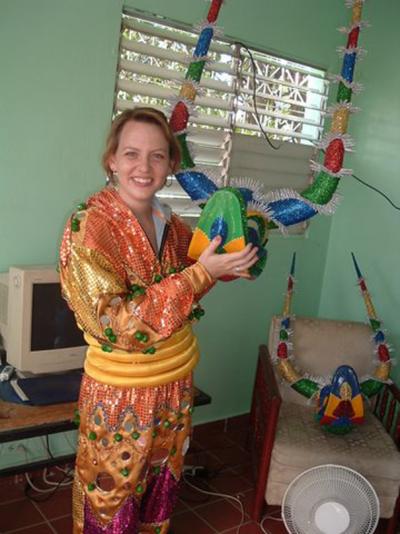
I quickly realized that I had had no idea of what I was really in for. As it turned out, carnival was at least a six-weekend commitment, beginning on the last Sunday in January and continuing into March, and it would result in the loss of several pounds. The many kilometers we had to walk, the dancing and jumping about, the intense heat inside the jumpsuit, the weight of it combined with the mask: all combined for a very sweaty and tiring experience. Not to mention the problem of the whip, which used muscles I’d never previously located and which I never quite mastered. I did better at the dance, which was a sort of high-stepping merengue with a rocking shoulder movement, and with the personality we had to display in order to pose for the ubiquitous photographers and shake hands with all the children.
My memories of carnival are therefore a mix of sweat, pain, exhaustion, brilliant colors, and very loud music. We would generally leave from our HQ, Betania’s house in Pueblo Nuevo, during the height of afternoon heat. Our disco lite, the local term for a pick-up truck mounted with enormous speakers and a deejay, was always waiting to lead the way with popular reggaetón and merengue music. Joining the flow of carnival groups from barrios even farther from the city center, we’d dance our way through the neighborhood, fueled by bottles of cheap rum and baggies of drinking water, stopping to greet friends ahead of and behind us as we went.
I got to know all the different comparsas, or traditional carnival groups: the muertos in spooky Halloween attire; the indios and the africanos, representing Dominicans’ mixed roots; the galleros, who enacted real, live cockfights along the route; and even Nicolás Den Den, the reincarnation of a Russian dancing bear who visited the city a century ago. There were new creations, too, including a group dressed as drug enforcement agents who staged a sting operation from their black SUV at every intersection. They had it easy in their air conditioning: every so often, all of us lechones would have to remove our masks to breathe and to wring the sweat from their foam linings. It was hard work.
Carnival did have its rewards, though, even beyond the rum- and merengue-fueled parties that followed each parade. For one, I got to be friends with the eight other lechones in my group as well as our security force, a bunch of teenagers who kept drunken and/or aggressive celebrants our of our paths so that we could drink rum and whack people with bladders in peace. Once, one of them proudly showed me that he was armed with a meat thermometer for my protection. Apparently, he intended to hold it in a closed fist in order to inflict puncture wounds, but the image in my mind was one of a frozen turkey attack.
I also got to know carnival politics from the inside. In contrast to the neighboring town of La Vega, whose groups of costumed devils receive corporate sponsorship that covers expenses from costumes and masks to music and drinks, Santiago’s lechones are basically on their own. The city-wide carnival federation is supposed to distribute a token amount to each group, but often seems to have trouble getting around to doing so. This particular year, things were so bad that we threatened to walk the entire carnival route in silence up to the famous Monument, the Muertos and their Chevy Impala of Death in the lead. Things didn’t come to that, but it was touch and go for a while.
In spite of such economic difficulties, I actually got paid once, when Jose asked me to form 1/14 of the Santiago delegation to a parade in Monte Plata. Carnavaleros from all over the country had been invited in order to assure a colorful finale to the Juegos Nacionales, a national sports competition that takes place every three years. For our day’s work, which lasted from our 6 AM departure from Santiago to our 9 PM return, and included a lengthy parade route in sweltering heat, we received a snack, lunch, and 400 pesos (about $12 US), officially making me a professional lechón.
Now that I’ve returned to teaching, my carnival days are at an end – for now. Someday I’ll don the sausage belt once again. But in the meantime, it’s enough to have discovered that while the view from the inside of a papier-mache mask may be limited to what can be seen through two narrow, crescent-shaped slits, it also offers a whole new perspective on Dominican culture. Well, that plus 12 bucks and an innovative weight-loss plan.
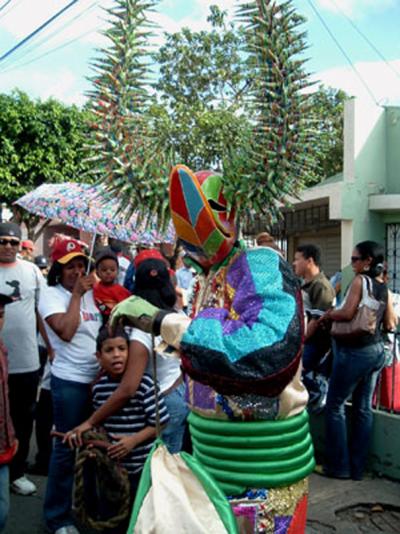
Biography
Published on April 01, 2011
Last updated on June 27, 2023
